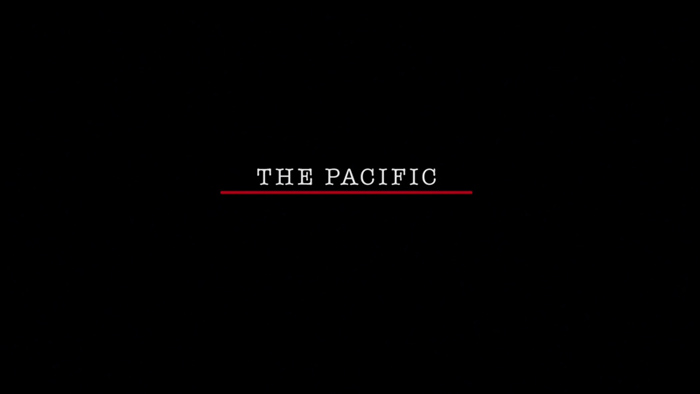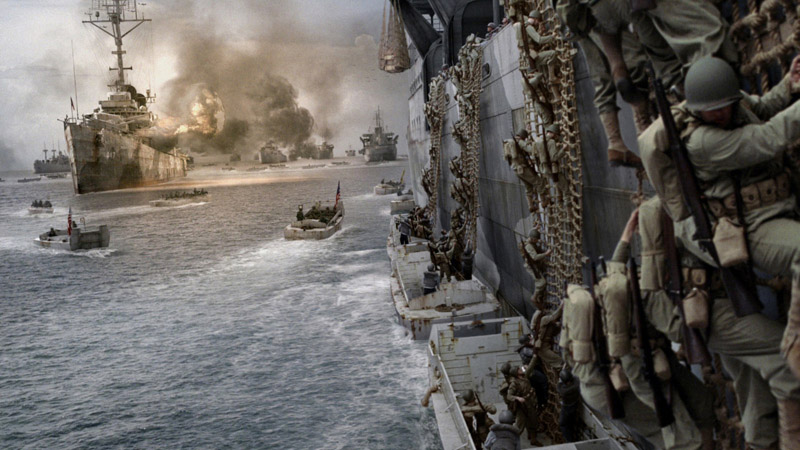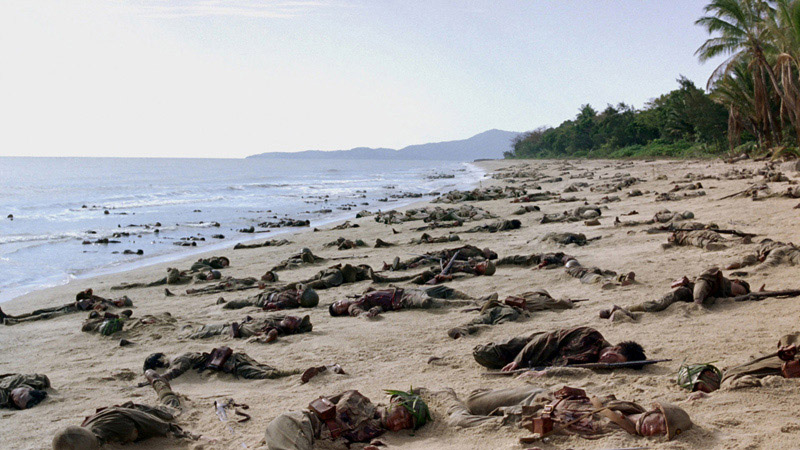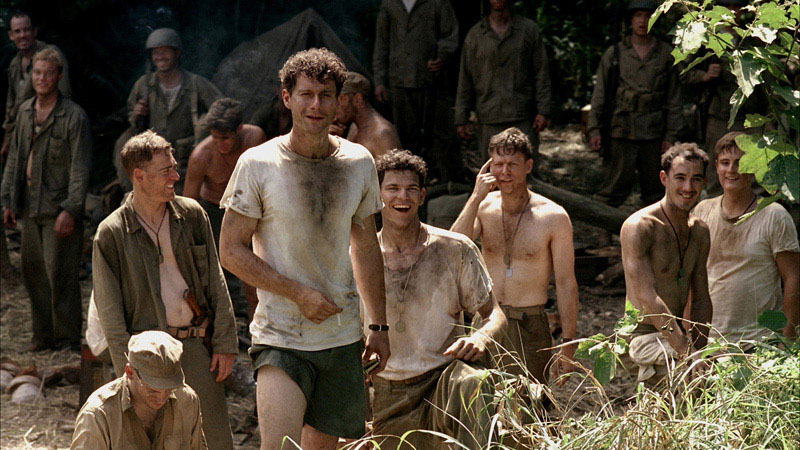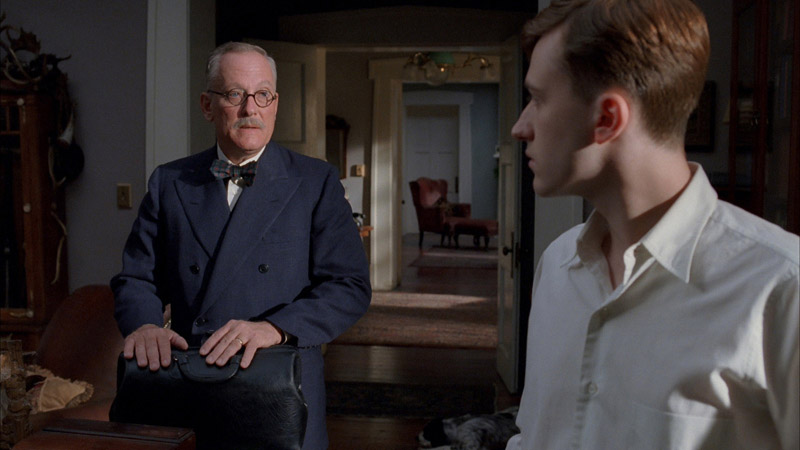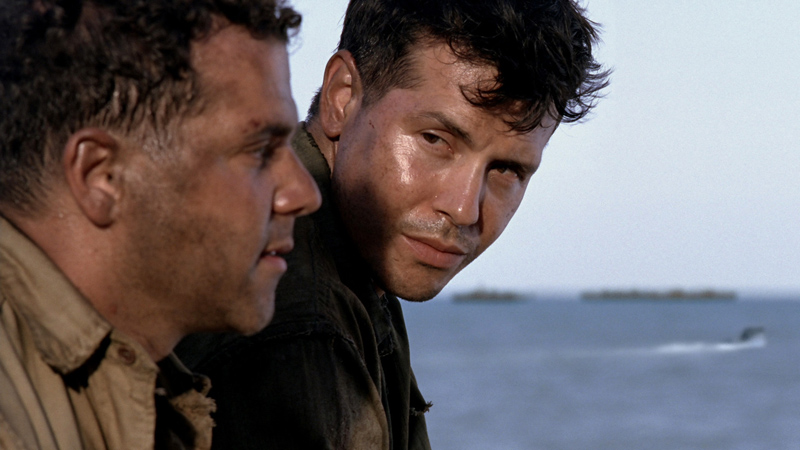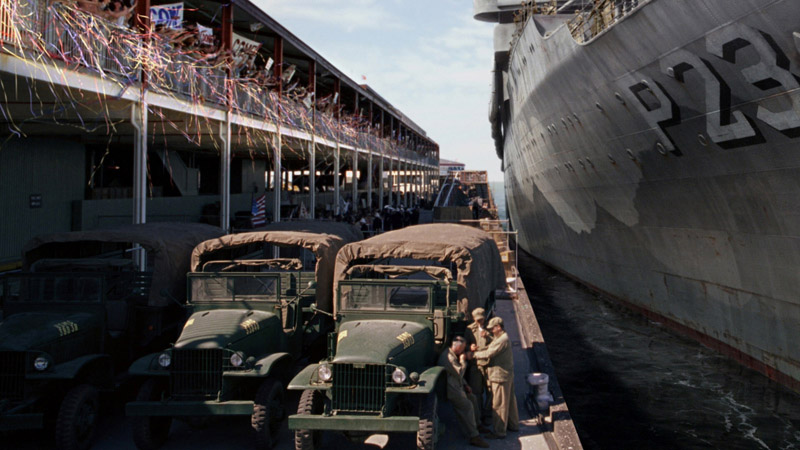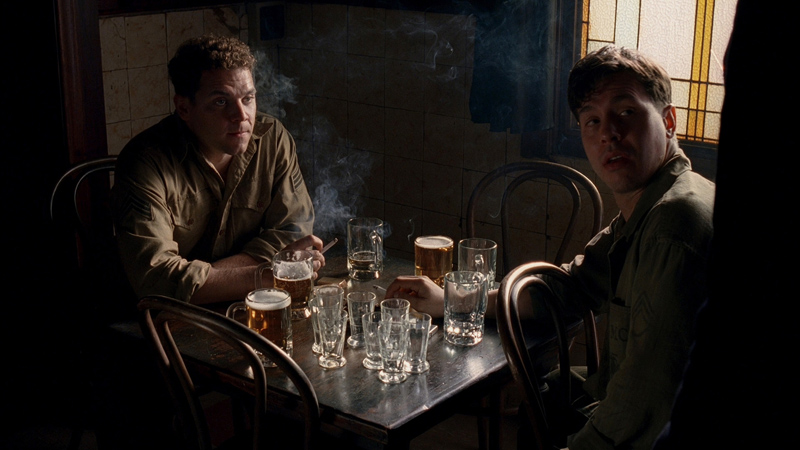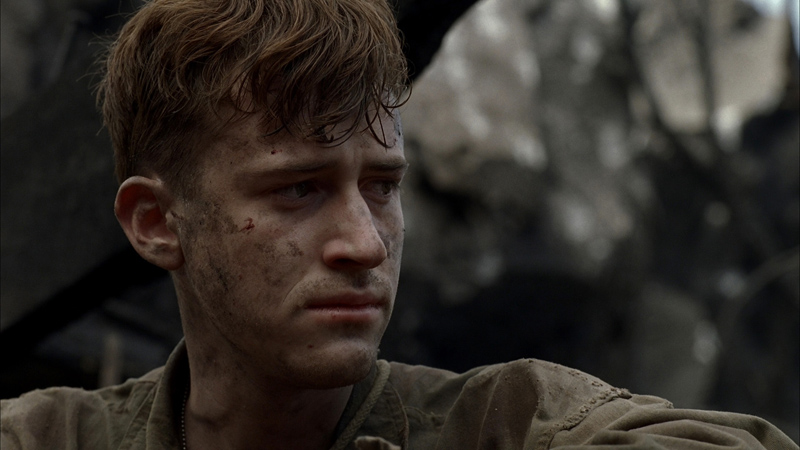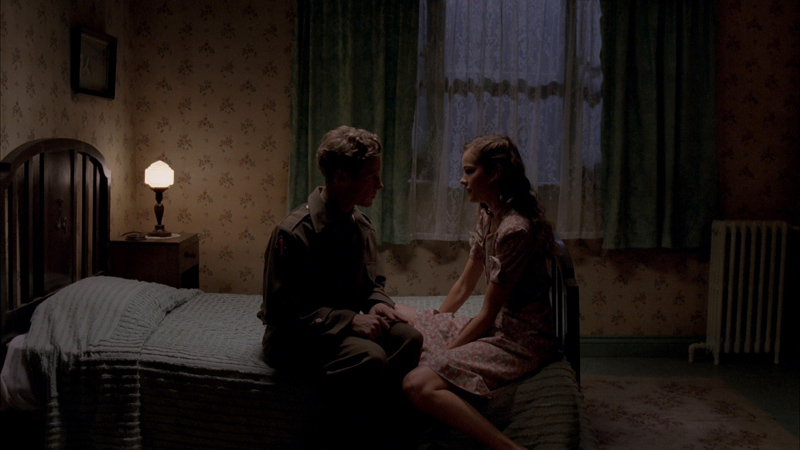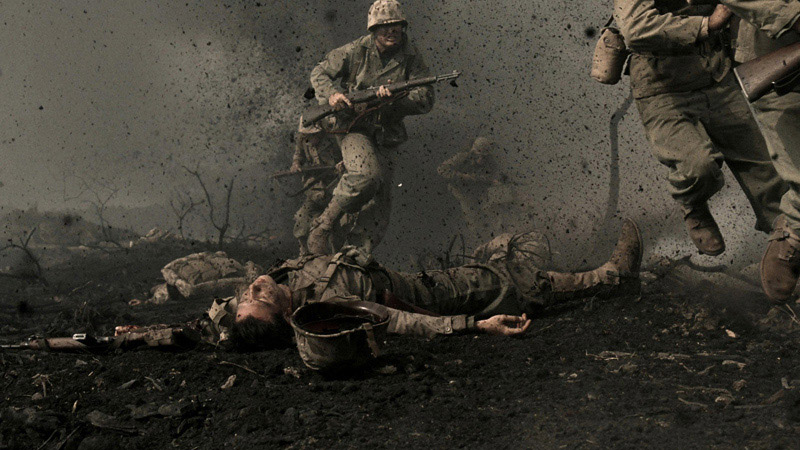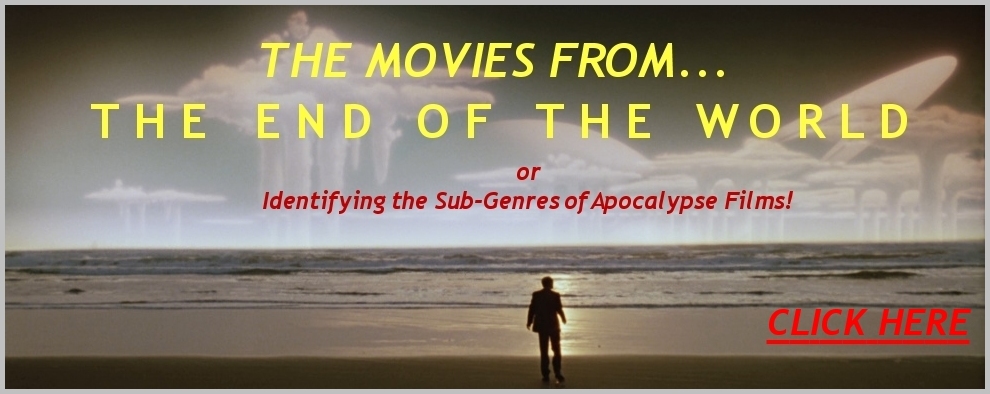Review by Leonard Norwitz
Production:
Theatrical: Dreamworks SKG & Playtone
Blu-ray: Home Box Office
Disc:
Region: FREE!
Runtime: approx. 530 minutes
Disc One Size: 42,438,188,668 bytes
Average Feature Size: 15,112,237,056 bytes
Video Bitrate: 18.05 Mbps
Chapters: 10
Case: Gatefold Box in “Band of Brothers” Tin: BRD x 6
Release date: November 2nd, 2010
Video:
Aspect ratio: 1.78:1
Resolution: 1080P / 23.976 fps
Video codec: MPEG-4 AVC Video
Audio:
English DTS-HD Master Audio 5.1 (48 kHz / 4177 kbps /
24-bit)
French DTS-HD Master Audio 5.1
Spanish DTS-HD Master Audio 5.1
Polish DTS Audio 2.0
Spanish DTS Audio 2.0
English DTS Express 2.0
Subtitles:
English, French, Spanish, Czech, Danish, Dutch, Finnish,
Greek, Korean, Norwegian, Polish, Portuguese & Swedish and
none
Extras:
• Enhanced Viewing
• Field Guide
• Historical Backgrounds - Tom Hanks
• Profiles of The Pacific - in HD (approx 48 min.)
• Making The Pacific - in HD (22.35)
• Anatomy of the Pacific War - in HD (10.00)
Description: The Pacific is the ten-part sister series to HBO’s
Band of Brothers: a portrait of WWII's Pacific Theatre
as seen through the eyes and hearts of three U.S. Marines -
Robert Leckie, John Basilone and Eugene Sledge. We follow
them from Guadalcanal to Cape Gloucester, Pavavu, Peleliu,
Iwo Jima, Okinawa, and their triumphant, yet uneasy, return
home after V-J Day. HBO is releasing the series
simultaneously on both Hi-Def Blu-ray and DVD, each with six
discs.
The Film:
9
A war movie stands or falls on it ability to portray the
thousand-yard stare. It’s that look that a soldier will have
after only a couple of days of continuous combat, that
shellshocked gaze that stares into an infinity beyond the
horrific reality that they have endured and must endure
again, and again.
The young Marines that are sent Guadalcanal, many on their
first combat mission, are pumped up for action, giddy with
the fantasy of the battle to come and with that peculiar
sprit de corps that only the American Marine can conjure. As
the reality of battle settles in, their faces reflect some
nameless contradiction. Disturbing beyond measure is not
only the sudden, irrational death of their comrades, but the
fanatical pursuit of death by their enemy. It strikes the
Marine as appallingly unnatural that Japanese soldiers would
fling themselves into the face of relentless machine gun
defenses whose end can only be certain death.
The camera fixes on the faces of the battle weary Marine as
he contemplates such otherworldly moments that seem to last
forever, then on a sea of corpses that was the night’s work.
The faces look familiar, not because we recognize the actors
(in many cases, we aren’t likely to) but because we know
them from photographs of war correspondents. Yes, I would
say that HBO nails the thousand-yard stare down pretty well.
A great deal, of course, depends on casting (for which the
series won the Emmy in their category): In the principle
roles are Joseph Mazzello, James Badge Dale and Jon Seda as
the real-life Marines PFC Eugene Sledge, PFC Robert Leckie
and Sgt. John Basilone, respectively. These men, together
with the many supporting actors who portrayed the soldiers
of the 1st Marines, have that wide-eyed, can-do look that we
associate with mid-century Americans, and that spirit of
invincibility that is inculcated into every Marine, only to
have those expressions seared off in the continuous hours
and days of battle and unexpected heavy casualties. Special
mention to an extensive supporting cast, including Zoe
Carides as the open-hearted mother of a girl that gets
involved with Leckie in Melbourne, Tom Budge as a soldier
very much at the end of his candle, Rami Malek as “Snafu”
Shelton, William Sadler at Lt. Col. “Chesty” Puller, and
Matt Craven as a Navy psychiatrist - five among many that
leap to mind.
Comparisons are inevitable, invited I should say, to HBO
most popular TV-to-video series, Band of Brothers. It was
created by Bruce McKenna (who also wore writing and
producing hats), one of the main writers on Band of
Brothers. Hanks and Spielberg exec-produced both series; and
Remi Adefarasin was responsible for principal photography.
The key difference lies in their titles: In Band of Brothers
we follow a single company of the 101st Airborne throughout
the European campaign of WWII. In The Pacific, while three
men are central, they meet only tangentially. Platoons are
broken up and members reassigned rather more frequently than
we are used to seeing in stories such as this. The sense of
chaos at all levels is primary, each episode has scarcely a
narrative thread to hang onto before it is left and picked
up loosely elsewhere.
The impressions are subjective and more intimate than in
Band of Brothers. We are as much in the heads of the Marines
as we are in the war, from the jungles of Guadalcanal to the
rocky landscapes of Okinawa, from the black sands of Iwo
Jima to the coral beaches of Peleliu, from the incessant
rains of Pavavu to the emotionally complex return home. The
soldiers fight the enemy without and within: the relentless
Japanese, of course, but also their own psyche and sometimes
their comrades. And always the jungle: the rains, heat,
dysentery, malaria, fatigue, madness.
A key decision in respect to the video version of the series
is the reassignment of Tom Hanks’ introductory remarks that
preceded and set the stage for the televised episodes. (They
are now relegated to an optional choice of Play.) The effect
of his comments created a more documentary feel to the
series. Watching the series without them, there is more of a
build-up, and more importantly, the glue that Hanks offered
in the way of perspective, now absent, drives home the
grunt’s point of view: to carry out the orders of their
commanding officers without knowing the whys or the big
picture. And while they often have a pretty good idea of
what sort of enemy force is arrayed before them at any
moment, the camera only pulls back for fleeting moments to
tell us where we are in the pacific, if not why.
My only criticism of the series (besides the long-accepted
designation “miniseries” - now part of the HBO logo - which,
to my ear, makes less of the experience and the investment)
is the price paid for coverage and authenticity: namely, a
compelling narrative coherence. I’m not suggesting the
filmmakers should have done this, but you can easily grasp
how much less scattered and more driven The Pacific would
have been if it had settled on one Marine, with asides to
several others. It’s a judgment call, and I don’t really
feel we are much the worse for it.

Image:
9/9
NOTE:
The below
Blu-ray
captures were taken directly from the
Blu-ray
disc.
The Pacific was shot on 35 mm film and subjected to a modest
amount of processing for the battle sequences before finding
its way onto HDTV and Blu-ray . The look for The Pacific
changes subtly depending on the location, with moderately
grainy, somewhat filtered and desaturated, higher contrast
images for the battle sequences and crisp, liquid, filmlike,
yet somewhat glossy images away from the heat of battle at
the home front and on R&R. The transfer reliably presents
these distinctions with very few difficulties (I noticed
only a smidgen of edge enhancement), no DNR or noise to
speak of despite extended night scenes.
The color and contrast for the daytime war scenes harkens
back to familiar documentary photography of the period
without actually imitating it, thus making the transitions
to peaceable scenes less jarring and more of a piece. The
Pacific is not Soderbergh’s
Traffic. Even so, the color for
the scenes at home and in Melbourne have a ripe, luscious
color that enhances the reds, as if a reminder of the bloody
war the Marines must return to.
CLICK EACH
BLU-RAY
CAPTURE TO SEE ALL IMAGES IN FULL 1920X1080 RESOLUTION
Audio & Music:
10/8
In scenes of chaos, such as battles big and small, it’s so
easy for the mixing engineer to simply spread effects left,
right and behind to convey the impression of mayhem, taking
care to offer a few correctly fixed locational cues. I
usually permit a certain degree of laxity, figuring that to
get all of the effects in their correct locations is more
work than is necessary or, in some case, useful. Add a
little LFE, some screaming mortars, some screaming soldiers,
the whiz of bullets and that should sell the program pretty
well.
In my opinion those responsible for the sound design for The
Pacific have earned the High Definition Video Oscar for Best
Sound not only for this year, but perhaps for all years up
until now. Indeed the series won and/or was nominated for a
number of sound-related Emmys. (Sound Mixer Michael Minkler
was also on board for
Black Hawk Down – ‘nuf said!) More
care was taken to make precise the myriad of arms fire than
I have ever heard before in a home theatre experience.
Especially effective are the night battles where we can’t
see what is hit, but only where the fire has started from
and the occasional tracing round to understand its
trajectory. The effect with a properly tuned high definition
audio playback system is as frightening as it is riveting.
It is not only the locational cues that hold our attention,
but more important: the size, shape, timbre and
bone-crunching impact of all manner of firepower, from hand
guns and M1 rifles and carbines to BAR’s and 50 mm machine
guns to mortars and other explosives, to the muffled cough
of distant canon and small arms fire. LFE is properly judged
and never exaggerated just to prove itself.
And that’s just the big stuff. We haven’t even got to the
beach landing at Pelelui, which will knock your proverbial
socks off.
When the Marines enter the jungles of Guadalcanal they are
met with a living, enveloping organism of insects, birds,
rain (the distinction between falling rain on the ground, on
the trees and suspended canvas is appreciated).
Thunderstorms have a haunting magic. There is nothing living
that does not contribute its unique sound to the magical
cacophony that is the jungle. There is no way to distinguish
the enemy from the trees. The jungle would suddenly open
fire, several Marines scream out, then you knew.
Dialogue is another instance of movie magic. I was unable –
and, by this time, unwilling – to tell if the dialogue
during the scenes during, before and after a battle was live
or looped. I noticed no telltale signs of soundstage effect.
It all seemed to work, even if what we hear might not have
been the way voices sound in that particular landscape.
In the big moments, the music tends to become generic: like
James Horner meets Randy Newman. But in the more subtle
scenes, the music enhances the material instead of trying to
compete with it.

Operations:
4
I didn’t much care for the menu layout in general. Too many
things are hidden, for example Hank’s historical
backgrounds, and we sometimes suffer a circuitous route to
get from one place to another. Subtitles cannot be accessed
from the remote. God help you if the language you wish to
see is at the top of a list of thirteen where you have to go
through each one until you reach yours. Nor can you get in
and out of Enhanced Viewing mode directly from your remote
as you could with Universal’s U-Control. Instruction for the
Enhanced View include this murky travel advisory: “Press the
< and > buttons on your remote control to skip forward and
backward between picture-in-picture content.” I tested this
instruction and never quite fugured out what was meant by
it. A minor detail to some: considering the fact the
Japanese figure prominently in this series, there are no
subtitles for those speak only that language!
Make sure your player has the most up to date firmware, as
it may be necessary to access the Enhanced Mode feature as
well as the Field Guide.
Extras:
8
HBO offers no audio commentaries for The Pacific. Instead
there are several options for learning about production and
background: The first are the three bonus features that
comprise the final disc in the set: “Profiles of the
Pacific” (interviews with people intimately acquainted with
six of the Marines depicted in the series), “Making The
Pacific” (a brief documentary about production issues and
special effects, authenticity, and training of the actors)
and “Anatomy of the Pacific War” (a discussion of Japanese
and American attitudes and propaganda going into the war.
Who thinks up these titles! Then there are the scattered pop
up banners and PIP comments that crop up throughout each
episode in a feature called “Enhanced Viewing” – another one
of those terms that reinvents the meaning of language - that
offers plenty of ongoing commentary by historians and those
involved with the making of the series. Finally we can find
Tom Hanks’ Historical Background introductions to several of
the episodes hidden under the Play Episode button.
|
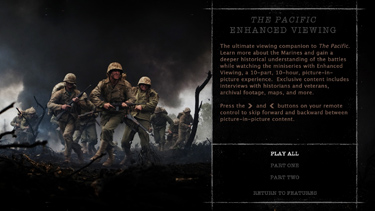 |
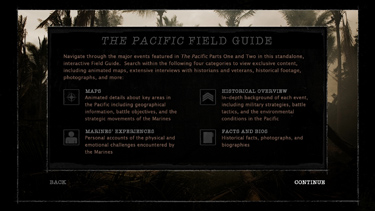 |
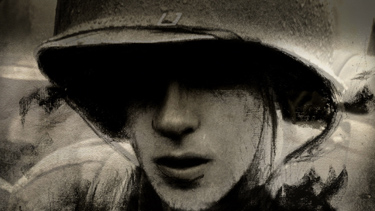 |
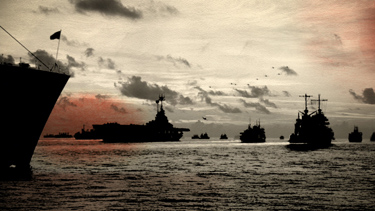 |
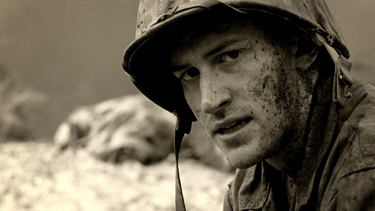 |
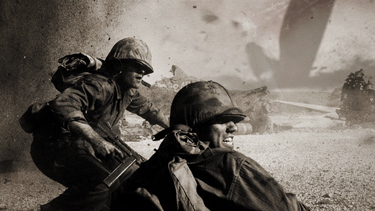 |
Bottom line:
9
The Pacific is an ideal series for home theatre viewing.
With front projection or sizeable flat screens and a serious
high-definition surround sound system we are transported,
safely, into a world that few of us now living ever knew,
even if our fathers did. There is much to learn - in many
instances, to learn all over again. There is comment in the
Extra Features that - rather unwittingly, I should think -
warns against the tyranny of a colonial power whose
manifesto is the domination of lesser peoples.
Taken at face value, the drama that is the lives of Bob
Leckie, John Basilone and Gene Sledge as they played their
part in that great war is powerful stuff. As with Band of
Brothers, cliche is rare (war, after all, is something of a
cliche, is it not; sentimentality is left at the door
altogether. Bombs really do burst in the air and we are hurt
as are they.
As for the high definition part of the package: The Pacific
looks great and will likely become a benchmark for sound
reproduction.
Highly recommended, despite the clumsy menus.
Leonard Norwitz
October 16th, 2010
![]()
![]()

![]()
![]()
![]()
![]()

![]()
![]()



